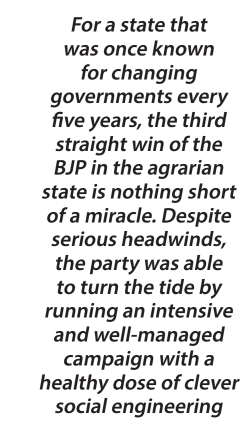
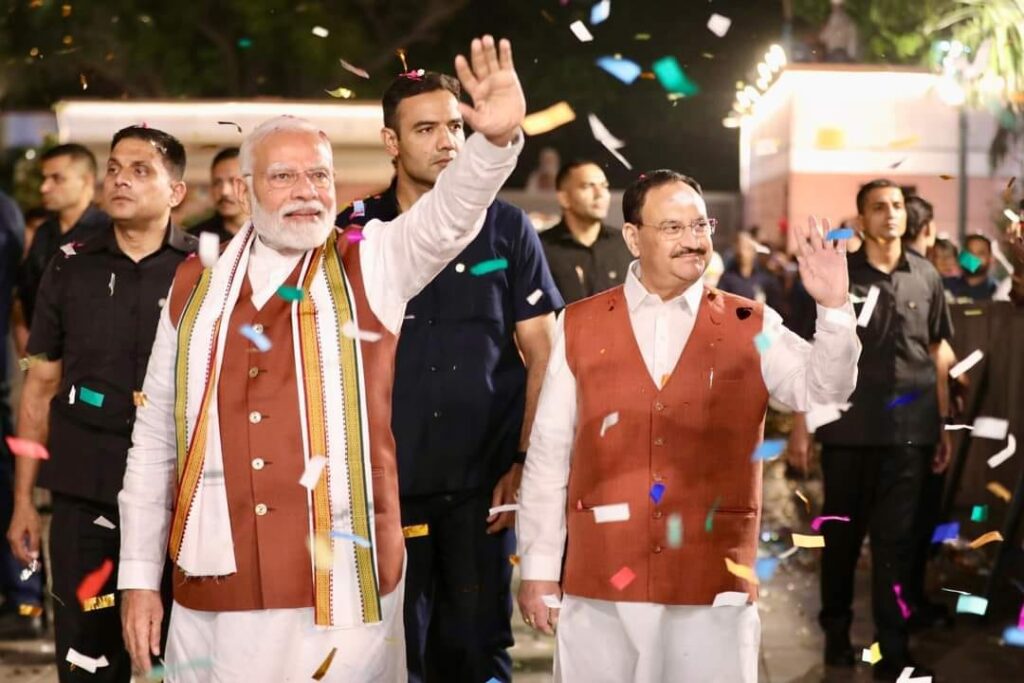
The political temperature in
Delhi, which is surrounded by Haryana on three sides, has started to rise. To some extent, politics on the outer rim of Delhi, bordering Haryana, is influenced by developments in the agrarian state. With the BJP
pulling off its third straight win in Haryana—a historic first—the party has plenty
of reasons to be optimistic about its prospects in the upcoming elections in Maharashtra and Jharkhand, which will be held later this month, and Delhi, where polls are
scheduled for early next year. The Congress once again lost in Hary
ana due to overconfidence and even went to the extent of blaming the electronic voting machines for its defeat. On the other hand, the BJP took bold steps in view of the lessons learnt from the 2024 Lok Sabha
elections and ran a micro-level campaign that convinced the voters who had drifted away from the party in the general election
to return. The Haryana results also considerably increased Prime Minister Narendra Modi’s stature
in popular perception as people still believe in Modi magic at the hustings. The results also vindicated Modi’s political acumen
in transferring the state’s leadership from
Manohar Lal Khattar, a Punjabi Khatri, to Nayab Singh Saini, hailing from the backward Saini community, just nine months before the elections were due. In the end, the projection of an OBC community face as the top lawmaker in the state played a crucial role in turning the Haryana elections into a Jat versus non-Jat contest, in which the BJP prevailed over the Congress. To some extent, the BJP was also helped by Bhupinder Singh Hooda’s stubborn refusal to balance the caste equations during ticket distribution. With Hooda Sr calling the shots in Haryana, the party’s high command in Delhi didn’t have much
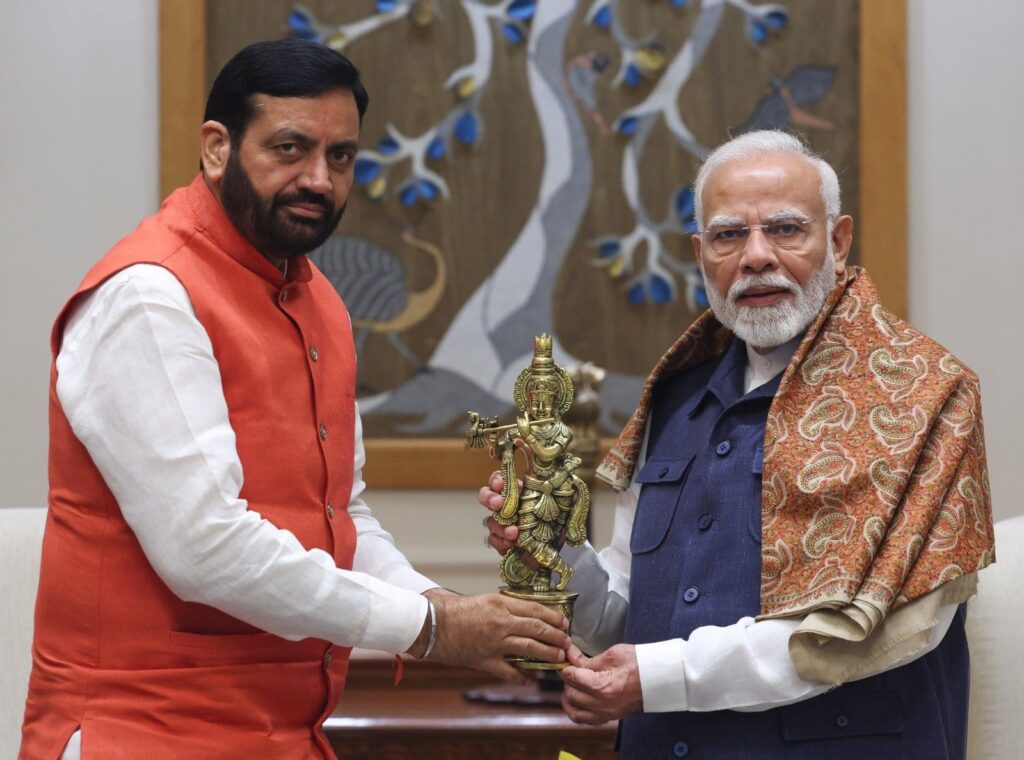
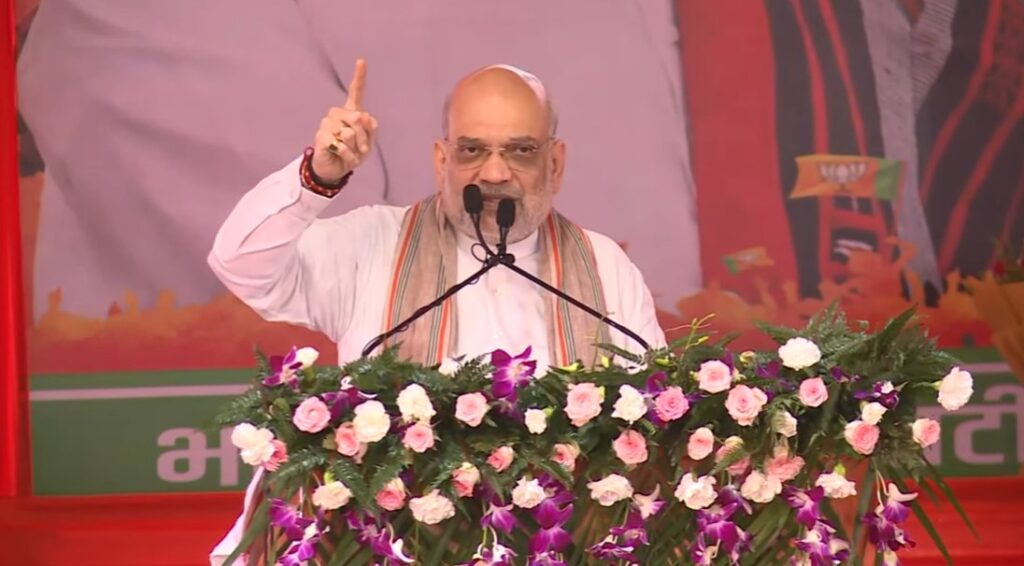
The Haryana win will swing the momentum back in favour of Modi and the BJP
say in candidate selection.
The Haryana electoral outcome will serve as a shot in the arm for the BJP after it fell short of expectations with just 240 seats in the Lok Sabha elections this May and failed to cross the simple majority mark for
the first time in three general election cycles. On the other hand, the Congress’ loss in Haryana will have a bearing on the INDIA coalition. There are already murmurs of discontent within the alliance. Detractors of the INDIA bloc are already pointing to the Congress’ failure to accommodate
parties like the Aam Aadmi Party (AAP) and Samajwadi Party (SP) in Haryana.
Maths turned in BJP’s favour
It is important to grasp the electoral arithmetic of Haryana to understand
how the BJP won the state which most political experts had written off for the
party. Haryana has the highest number of Jat voters, but other castes are more in number. In every election, Jats prefer to
vote for the party which makes a Jat leader the chief minister. History is witness to the long list of Jat chief ministers in Haryana
such as Devi Lal, Om Prakash Chautala, Bansi Lal and Bhupinder Singh Hooda. But it is Bhajan Lal, a non-Jat, who holds
the record of being the longest serving
chief minister. This is the formula that the BJP started working on even before the
2024 Lok Sabha elections. Making Saini, hailing from the OBC community and a
sitting MP from Kurukshetra, the chief
minister was part of the plan that helped to beat the anti-incumbency factor that
had set in after two terms of Khattar at the helm. By putting Saini at the forefront of Haryana politics, the BJP also managed to restrict the Congress to five seats in the
general election for an even split of five seats each. In the 2019 parliamentary election, the BJP had swept the state by winning all 10 seats.
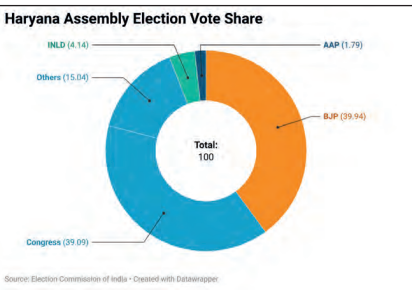
up Haryana’s demographic distribution.
He also points out that a spate of welfare
schemes for the backward communities too
worked in the BJP’s favour.
The BJP managed to retain 67% of the
seats it had won in the last election, besides
winning 22 new seats. In the 2019 assembly elections, the BJP had retained just 27
out of 40 seats. This means that, this time,
it won two out of every three existing seats
besides adding 22 new seats. In contrast,
the Congress won 19 new seats but could
retain only 50% of the seats it had won last
time. This did not help the Congress to up
its tally.
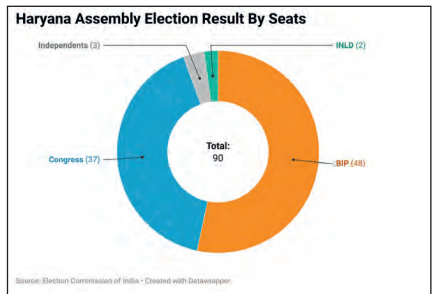
Punjab and Haryana have
been the epicentre of the
farmers’ agitation. Gurnam
Singh Charuni, who was
one of the leaders of the
movement in Haryana,
received only 1,170 votes
in Pehowa Assembly constituency, which indicates
that in the end the ongoing
agitation by the farmers
had little impact on the
electoral outcome
The failure of the Congress to forge an
alliance with AAP directly benefitted the
BJP, especially in those Assembly constituencies that witnessed a close contest. The
statewide vote share difference between the
BJP (39.94%) and the Congress (39.09%)
was a mere 0.85%, while AAP garnered a
1.79% vote share. If Haryana is any indicator, then in the Delhi Assembly elections
too the Congress and AAP are likely to
contest separately, which means advantage
accrues to the BJP.
Punjab and Haryana have been the epicentre of the farmers’ agitation. Gurnam
Singh Charuni, who was one of the leaders
of the movement in Haryana, received only
1,170 votes in Pehowa Assembly constituency, which indicates that in the end the
ongoing agitation by the farmers had little
impact on the electoral outcome. However,
Charuni went on to blame Hooda for failing to capitalise on the anti-BJP sentiments
that fuelled the farmers’ movement. Similarly, senior Congress leader Ashok Buwaniwala from Bhiwani pinned the Haryana loss on the failure to strike the correct
caste equations in ticket distribution in the
state unit’s leadership. In contrast, Randhir
Singh Panihar, the newly elected MLA from
Nalwa, says that the BJP won because it was
able to find the right balance between the
36 biradaris (36 communities) that mak
BJP increases its tally in four belts
Haryana is divided into seven cultural and political belts. The BJP increased its seats in four of these seven areas compared to 2019. There was no change in Bagarh, South Haryana and
Mewat areas. However, in the remaining four regions, the BJP improved its performance. GT Road belt: The six districts along the
road from Delhi to Chandigarh fall in the GT Road belt. This includes 23 seats in Panchkula, Kurukshetra, Panipat, Yamunanagar, Karnal and Ambala. A large chunk
of the population in these districts are Punjabis, who migrated from Pakistan after the
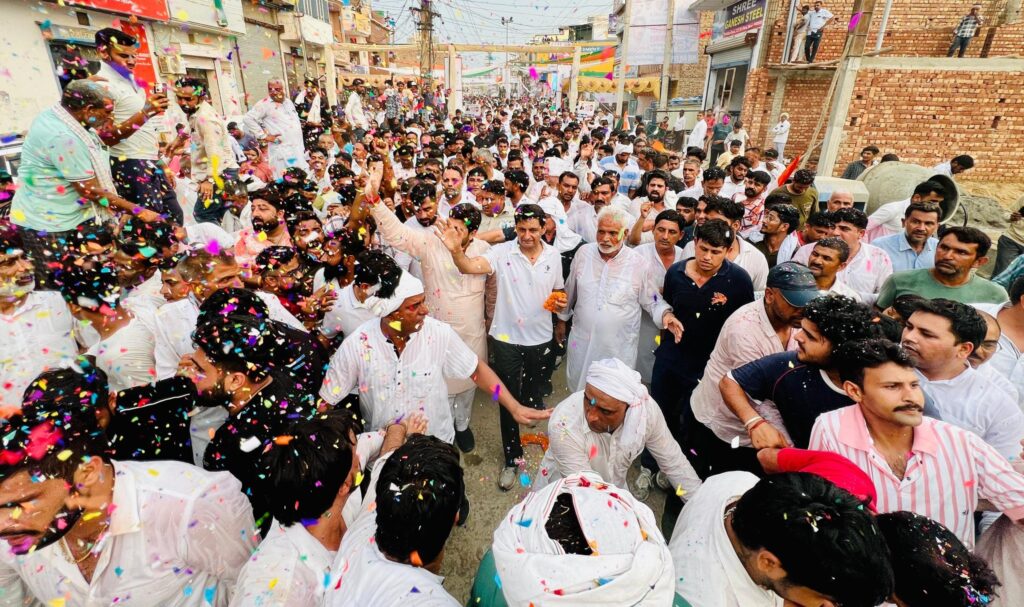
Much of the blame for faulty ticket distribution of the Congress lies with the former Chief Minister Bhupinder Singh Hooda
Partition in 1947. The BJP had won 21 seats from this belt in 2014 and 12 in 2019. This time, the BJP picked up 14 seats in this belt.
Bangar belt: Haryana’s two districts, Jind and Kaithal, adjoining Punjab, fall in the
Bangar belt. There are a total of nine seats in these two districts. The BJP had won two of these seats in 2014 and three in 2019. This
time the BJP won five seats in the Bangar belt—an increase of two seats.
Deswal belt: It is also known as Jatland.
The belt comprises three districts, Rohtak, Jhajjar and Sonipat, and has a total of 14 assembly seats. The BJP had won four seats in
2014 and two in 2019. This time, the BJP has managed to win four seats.
Baggad belt: This is the region that borders Rajasthan and Punjab and has Bagri-speaking and Punjabi voters. This belt comprises five districts—Hisar, Sirsa, Fatehabad, Bhiwani and Charkhi-Dadri. There are a total of 21 seats. The BJP had won six seats from this belt in 2014 and eight in 2019. In this
election, the BJP held on to its 2019 numbers by winning eight seats.
Ahirwal belt: The region comprises the districts of Gurugram, Rewari and Mahen
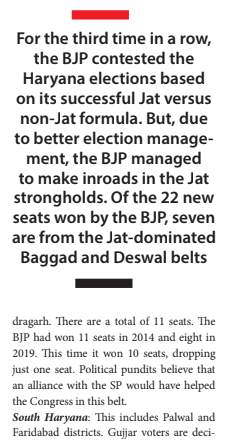
sive in nine seats of this area and are mostly Braj language speakers. The BJP had won just three seats in 2014 and seven in 2019. In
this election, the BJP held on to seven seats.
Mewat: This region is dominated by Haryana’s Meo Muslims and has three seats. In 2014 and 2019, the BJP did not win any seat here and this time also the BJP did not win any seat here. Therefore, it was no loss for the party. For the third time in a row, the BJP
contested the Haryana elections based on its successful Jat versus non-Jat formula. But, due to better election management,
the BJP managed to make inroads in the Jat strongholds. Of the 22 new seats won by the BJP, seven are from the Jat-dominated
Baggad and Deswal belts. Apart from this, the Punjabi- and urban-dominated GT Road belt was considered the weakest link for the BJP by election pundits, but the BJP
has won seven new seats there as well.
Fresh faces do the trick
The BJP changed as many as 22 tickets, out of which 12 candidates won. Out of the
total 90 seats it contested, it won 48 seats
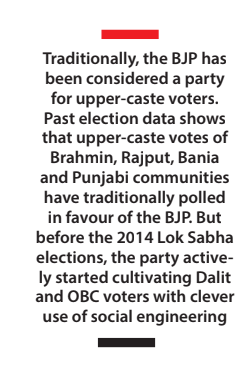
(Clockwise) AAP cut into the Congress’ votes, especially in closely contested seats.
or about 54%. The results indicate that the changing of candidates facing anti-incumbency paid off handsomely for the BJP. An
inkling of the BJP’s strategy of finding fresh faces to beat the anti-incumbency factor
and Khattar’s mishandling of the farmer agitation and the women wrestlers’ issue
came in March when the central leadership of the party replaced him with Saini. The ascent of Saini was also a reassuring signal
to the state’s 44% OBC population that has been the party’s target for effecting an anti-Jat consolidation. Khattar’s absence from
the campaign and election posters and advertisements helped to soften the damage
to a great extent. Out of the four rallies that Modi held in Haryana, Khattar was presen
in only one. A BJP internal survey before the Lok Sabha elections showed that the
two-term chief minister had become extremely unpopular with the people.
Traditionally, the BJP has been considered a party for upper-caste voters. Past
election data shows that upper-caste votes of Brahmin, Rajput, Bania and Punjabi communities have traditionally polled in
favour of the BJP. But before the 2014 Lok
Sabha elections, the party actively started cultivating Dalit and OBC voters with clever use of social engineering. Despite the Jat
community, which makes up 27% of the state’s population, going against the BJP, the rainbow of social coalitions more than
made up.
Haryana has 17 seats reserved for Scheduled Castes, who constitute around 20% of the state’s population. In 2019, the
BJP had won four of these seats. The BJP won eight seats this time. There are two types of voters in Haryana—vocal voters, usually Jats, and silent
voters, who generally hail from Dalit and backward communities. For the BJP, it was the silent voter that carried the day in these
elections despite opinion polls predicting a big loss for the party. Most pollsters failed to capture the
mood of the silent voters. Political analyst Kamlesh says, “Most of the non-Jat voters in Haryana kept to themselves, away from
the issues of the farmers, wrestlers and
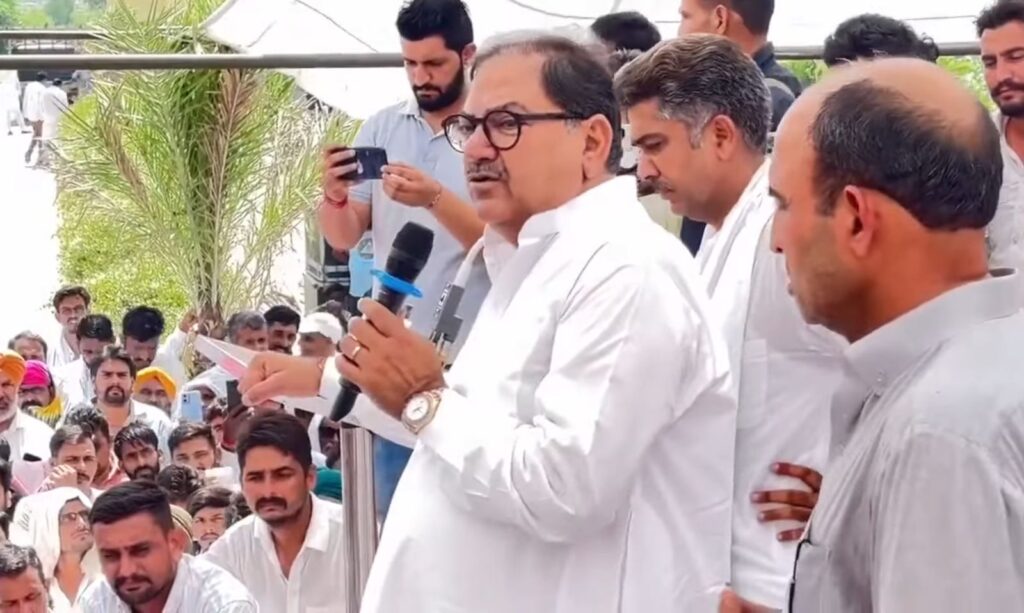
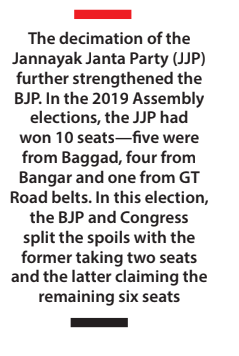

jawans. They believed that these issues affect only the Jat voters.” The decimation of the Jannayak Janta
Party (JJP) further strengthened the BJP. In
the 2019 Assembly elections, the JJP had won 10 seats—five were from Baggad, four from Bangar and one from GT Road belts. In this
election, the BJP and Congress split the spoils
with the former taking two seats each in the Bangar and Baggad belts and the latter claiming the remaining six seats. After the 2019 polls, the BJP and the JJP
had formed a coalition government. The JJP’s
Dushyant Chautala became the deputy chief minister, but in March 2024 the JJP broke off the alliance and decided to contest the elections on its own. The benefit of the alliance
with the JJP in 2019 went to the BJP in 2024 and the JJP’s share suffered.“The politics of JJP and INLD has been rejected by non-Jats.
In 2019, the JJP had contested against the BJP
but later formed an alliance and formed the government. This had angered the JJP’s core voters. There was resentment among JJP’s
supporters against the alliance with the BJP.
But the break-up of the alliance benefited the
BJP and damaged the JJP’s share,” says senior
journalist Manoj Bhalla.
Campaign saturation
The BJP held around 150 rallies in Haryana. Of these, four rallies were addressed
by Modi and 10 by Union Home Minister
Amit Shah. UP CM Yogi Adityanath also
held some rallies; besides, the BJP deployed more than 40 Union ministers and MPs to campaign across the length and breadth of
the state. The Congress, on the other hand, held only 70 rallies. Out of these, four rallies and two roadshows were conducted by the Leader of Opposition, Rahul Gandhi, while Priyanka Gandhi Vadra addressed
two rallies and held a roadshow along with
Gandhi. The Congress national president,
Mallikarjun Kharge, also conducted two rallies and there were some more by former chief ministers and MPs. But in the end, the BJP was able to input far more resources in the campaign, which turned the tide in its favour.


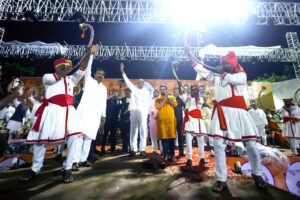
Add Comment